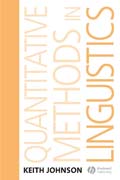
Quantitative Methods in Linguistics offers a practical introduction to statistics and quantitative analysis with data sets drawn from the field and coverage of phonetics, psycholinguistics, sociolinguistics, historical linguistics, and syntax, as well as probability distribution and quantitative methods INDICE: Acknowledgments . Design of the Book . 1. Fundamentals of Quantitative Analysis . 1.1 What We Accomplish in Quantitative Analysis. 1.2 How to Describe an Observation. 1.3 Frequency Distributions: A Fundamental Building Block of Quantitative Analysis . 1.4 Types of Distributions. 1.5 Is Normal Data, Well, Normal?. 1.6 Measures of Central Tendency. 1.7 Measures of Dispersion. 1.8 Standard Deviation of the Normal Distribution. Exercises. 2. Patterns and Tests. 2.1 Sampling . 2.2 Data . 2.3 Hypothesis Testing . 2.3.1 The Central Limit Theorem . 2.3.2 Score Keeping . 2.3.3 H0: µ = 100 . 2.3.4 Type I and Type II Error . 2.4 Correlation . 2.4.1 Covariance and Correlation . 2.4.2 The Regression Line . 2.4.3 Amount of Variance Accounted For . Exercises . 3. Phonetics. 3.1 Comparing Mean Values . 3.1.1 Cherokee Voice Onset Time: µ1971=µ2001 . 3.1.2 Samples Have Equal Variance . 3.1.3 If the Samples Do Not Have Equal Variance . 3.1.4 Paired t Test: Are Men Different from Women? . 3.1.5 The Sign Test . 3.2 Predicting the Back of the Tongue from the Front: Multiple Regression. 3.2.1 The Covariance Matrix . 3.2.2 More than One slope: The bi . 3.2.3 Selecting a Model . 3.3 Tongue Shape Factors: Principal Components Analysis . Exercises . 4. Psycholinguistics . 4.1 Analysis of Variance: One Factor, More than Two Levels . 4.2 Two Factors: Interaction . 4.3 Repeated Measures . 4.3.1 AnExample of Repeated Measures ANOVA . 4.3.2 Repeated Measures ANOVA with a Between-Subjects Factor . 4.4 The "Language as Fixed Effect" Fallacy . 4.5 Exercises . 5. Sociolinguistics . 5.1 When the Data are Counts - Contingency Tables . 5.1.1 Frequency in a Contingency Table . 5.2 Working with Probabilities: TheBinomial Distribution . 5.2.1 Bush or Kerry? . 5.3 An Aside about Maximum Likelihood Estimation . 5.4 Logistic Regression . 5.5 An Example from the [?]treets of Columbus . 5.5.1 On the Relationship between x2 and G2 . 5.5.2 More thanOne Predictor . 5.6 Logistic Regression as Regression: An Ordinal Effect - Age . 5.7 Varbrul/R Comparison . Exercises . 6. Historical Linguistics . 6.1 Cladistics: Where Linguistics and Evolutionary Biology Meet . 6.2 Clustering on the Basis of Shared Vocabulary . 6.3 Cladistic Analysis: Combining Character-Based Subtrees . 6.4 Clustering on the Basis of Spelling Similarity . 6.5 Multidimensional Scaling: A Language Similarity Space . Exercises . 7. Syntax . 7.1 Measuring Sentence Acceptability . 7.2 A Psychogrammatical Law? . 7.3 Linear Mixed Effects in the Syntactic Expression of Agents in English . 7.3.1 Linear Regression: Overall, and Separately by Verbs . 7.3.2 Fitting a Linear Mixed-Effects Model: Fixed and Random Effects . 7.3.3 Fitting Five More Mixed-Effects Models: Finding the Best Model . 7.4 Predicting the Dative Alternation: Logistic Modeling of Syntactic Corpora Data . 7.4.1 Logistic Model of Dative Alternation . 7.4.2 Evaluating the Fit of the Model . 7.4.3 Adding a Random Factor: Mixed Effects Logistic Regression . Exercises . Appendix 7A . References. Index
- ISBN: 978-1-4051-4425-4
- Editorial: Blackwell
- Encuadernacion: Rústica
- Páginas: 296
- Fecha Publicación: 01/02/2008
- Nº Volúmenes: 1
- Idioma: Inglés
